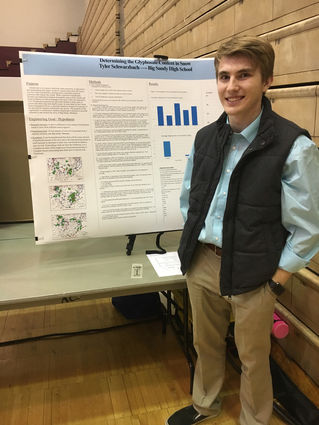Big Sandy students win awards at State Science
April 3, 2019

Tyler Schwarzbach, a BSHS Senior, stands in front of his science project board. He brought home the American Meteorological Society Award.
Tyler Schwarzbach, Hope Gasvoda, and Everett Works took their science projects to State. Hope and Evert took home silver awards. Tyler Schwarbach received the American Meteorological Society Award, and the University of Montana Environmental Science Award.
Tyler's science project was determining how much weed spray was detected in snow samples. His conclusion reads: "The experimental hypothesis can be accepted. Statistically significant quantities of glyphosate were detected in snow samples collected in and around Big Sandy, Montana. Two of the snowfall collection events originated from a Canadian air mass, while the third originated from the southeastern portion of Montana (as determined by weather maps and wind patterns). The experimental hypothesis that air masses from Canada carry a higher glyphosate concentration can be accepted. Further testing will be required to determine the statistical significance of this claim. The mild winter experienced in Montana prior to the testing date prevented additional collections which would have provided more definitive results."
Hope Gasvoda's science project explained in common language would be "Can Barley straw be used for Ethanol? However, her conclusion reads, "This experiment was performed to determine the most efficient pH buffer for the production of glucose in lignocellulosic biomass as a result of the enzymatic effects of cellulase. The lignocellulosic biomass used was barley straw, and it was pretreated using manual grinding and a five-minute steam treatment. The pH buffers were prepared in a range of 3-8. After the addition of 1.0 g of barley straw and 0.5 mL of cellulase to 10 mL of each pH buffer, the glucose levels were tested. The hypothesis was that the pH 7 buffer would produce cellulase most efficiently because ethanol has a pH of 7.33. The results indicated that the pH 5-8 buffers were most efficient, however, results of t-tests showed that the difference between the average glucose concentrations throughout the pH buffers was not statistically significant. This means that cellulase broke down lignocellulosic biomass and produced glucose efficiently across all six pH buffers."
Everett's experiment was researching frustration levels. Everett's conclusion states, "The purpose of this experiment is to determine which age group and gender have a higher level of frustration before and after they play a common videogame. It can be hypothesized that female subjects of the age range of 15-17 and male subjects in the age range of 18+ will have higher levels of frustration. This is due to the fact that puberty hits girls at an earlier age than boys, and when one goes through puberty, people tend to have less control of their emotions and tend to get more irritated by more miniscule obstacles. Furthermore, it can be hypothesized that people of the age 16 will have the highest level of stress due to the same reasoning as stated earlier."
"The hypothesis of this experiment was rejected. The data shows that the age group that has the highest average frustration score is the age 21, scoring a staggering average of 82 points out of one hundred. Male subjects in the age range of 15-17 have shown to be much higher than any other age group and/or gender with a staggering difference. There was a no difference in how subjects reacted to playing minesweeper, as the majority of subjects have shown to have a higher state of frustration after playing minesweeper. This is regardless of age and gender."





